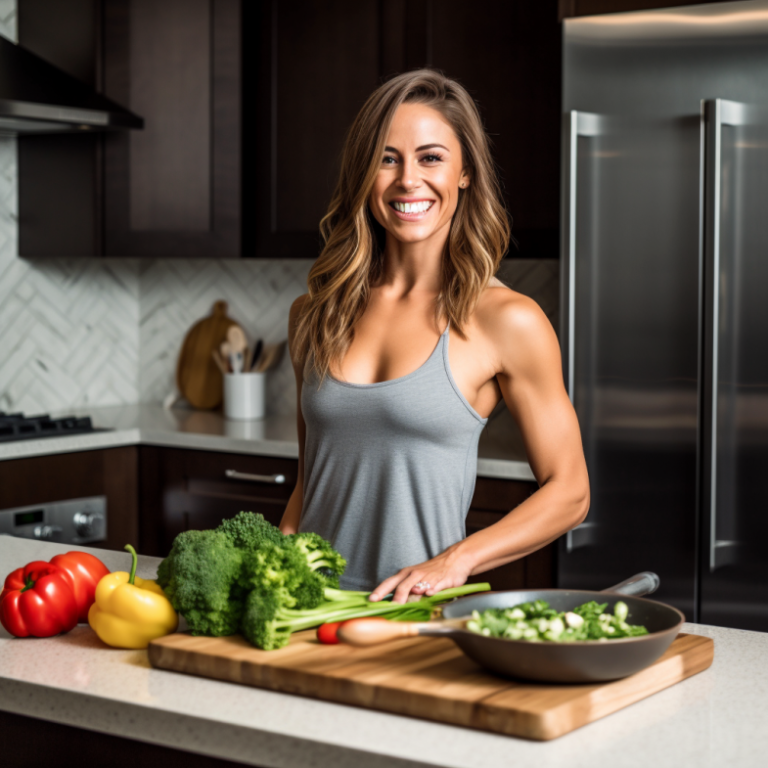Meal Prep 101 A Beginner’s Guide to Planning Your Diet
Meal prepping is the simple act of preparing whole meals or dishes ahead of schedule. It’s particularly popular among busy people because it can save a lot of time. Having pre-prepared meals on hand can also reduce portion size and help you reach your nutrition goals.
So, let’s dive into the world of meal prepping with this beginner’s guide.

Getting Started with Meal Prepping
Embarking on your meal prep journey can be both exciting and a bit overwhelming, but with the right tools and a solid plan, you’ll soon be prepping like a pro. Here’s how to get started:
Essential Tools for Meal Prepping
Before you dive into the world of meal prepping, having the right equipment is essential. A set of sharp knives will make chopping veggies and meats a breeze, while durable cutting boards (consider having separate ones for produce and meats to avoid cross-contamination) are a must-have.
Next, think about storage. You’ll need an assortment of containers—preferably glass or BPA-free plastic—with tight-fitting lids to keep your food fresh and prevent leaks. It’s also helpful to have a variety of sizes for different types of meals and snacks.
As for cooking, basic pots and pans are non-negotiable. A non-stick skillet, a large pot for soups and stews, and a sheet pan for oven roasting will cover most of your needs. A slow cooker or an instant pot can be a game-changer, allowing you to toss in ingredients in the morning and come home to a fully cooked meal.
Choosing the Right Recipes
Selecting the right recipes is the cornerstone of successful meal prepping. You’ll want to look for meals that are not only nutritious and delicious but also hold up well when stored in the fridge or freezer. Casseroles, soups, stews, and marinated proteins usually freeze and reheat well, making them perfect candidates.
Consider your dietary goals—are you trying to lose weight, build muscle, or simply maintain a healthier lifestyle? Choose recipes that support these goals. If you’re aiming for weight loss, for example, you might focus on lean proteins and lots of vegetables. For muscle building, you’ll want to include plenty of protein-rich foods and complex carbs.
Planning Your Meal Prep Strategy
Setting realistic goals is key when you’re just starting out. If the idea of prepping all your meals for the week is daunting, start with something manageable. Prepping your lunches can be a great way to get into the habit without feeling overwhelmed.
Creating a balanced meal plan is crucial. A well-rounded diet includes a mix of protein, carbohydrates, and fats. Lean meats, beans, tofu, whole grains, fresh vegetables, fruits, nuts, and seeds are all excellent choices. Make sure to include a variety of colors in your veggies to ensure you’re getting a range of nutrients.
When planning, consider your schedule. If you have more time on weekends, that might be the best time to do most of your meal prep. If you’re pressed for time, look for recipes that are quick to prepare or can be made in large batches.
Remember, meal prepping is about making your life easier and helping you stick to your dietary goals. With the right tools, recipes, and a solid plan, you’ll be well on your way to meal prep success.

The Step-by-Step Meal Prep Process
Embarking on meal prepping can streamline your week and help you stick to your nutritional goals. Here’s a detailed breakdown of each step to ensure your meal prep process is as efficient and effective as possible.
Step 1: Recipe Selection
The first step is to select the right recipes. Look for dishes that are not only packed with nutrients but also simple to prepare and suitable for bulk cooking. One-pot meals, like chili, stews, and casseroles, are excellent for meal prepping because they usually yield a large quantity and their flavors often improve over time. Additionally, consider recipes that use some of the same ingredients to minimize waste and save on your grocery bill.
Step 2: Grocery Shopping
With your recipes in hand, create a detailed shopping list. Organize your list by department (produce, meat, dairy, etc.) to make your shopping trip more efficient. Stick to your list to avoid unnecessary purchases that can lead to food waste and additional expense. Remember to check your pantry and fridge before you head out to avoid buying items you already have.
Step 3: Prepping Ingredients
Once you have all your groceries, start by washing and drying all your produce. Chop vegetables, marinate proteins, and measure out spices and herbs. This is also the time to cook grains like rice or quinoa and beans if you’re using them in your recipes. Having everything prepped and ready to go will make the cooking process much faster and more enjoyable.
Step 4: Cooking in Batches
Now it’s time to cook. Using the batch cooking method, you can prepare multiple meals at once. This might mean roasting a tray of mixed vegetables while simmering a pot of soup and baking chicken breasts all at the same time. Utilize your oven, stovetop, and any other kitchen appliances you have to maximize efficiency. Remember to keep an eye on cooking times and temperatures to ensure everything is cooked properly.
Step 5: Storing Your Meals
After cooking, allow your meals to cool to room temperature before storing them to prevent bacteria growth. Portion out your meals into individual containers if you’re prepping single servings, or use larger containers if you’ll be serving family-style. Be sure to label each container with the contents and the date it was prepared. Most meals will keep in the fridge for a few days, while others can be frozen for longer storage. If freezing, make sure your containers are freezer-safe to prevent freezer burn.
By following these steps, you’ll have a fridge full of healthy, home-cooked meals that will make feeding yourself and your family throughout the week a breeze. Remember, the key to successful meal prep is in the planning – it ensures that you have a clear process from start to finish, which saves time, reduces stress, and helps you maintain a healthy diet.
Easy and Nutritious Recipes for Beginners
When starting out with meal prepping, it’s best to choose recipes that are straightforward but still packed with the nutrients you need to power through your day. Here are some beginner-friendly ideas that are as delicious as they are easy to prepare.
Breakfast: Overnight Oats
Overnight oats are a fantastic breakfast option because they’re not only nutritious and filling but also incredibly versatile. Start with a simple base: mix 1/2 cup of rolled oats with 1/2 cup of your milk of choice (dairy or plant-based), and a spoonful of chia seeds for extra fiber and omega-3s. From there, you can add a variety of toppings and flavors. Some great additions include:
- A tablespoon of natural peanut butter and sliced banana
- A handful of berries and a sprinkle of almond flakes
- A swirl of honey, a dash of cinnamon, and diced apples
- A spoonful of cocoa powder and a few dark chocolate chips for a treat
Mix your chosen ingredients in a jar or airtight container, seal it up, and let it sit in the fridge overnight. In the morning, you’ll have a creamy, ready-to-eat breakfast waiting for you.
Lunch: Quinoa Salad with Mixed Vegetables
Quinoa is a complete protein and makes an excellent base for a nutritious lunch. To make a quinoa salad, cook 1 cup of quinoa according to the package instructions and let it cool. Then, mix in a variety of colorful vegetables for a range of nutrients. Some great options include:
- Diced bell peppers for vitamin C
- Shredded carrots for beta-carotene
- Chopped cucumbers for hydration
- Cherry tomatoes for lycopene
- Spinach or kale for iron and calcium
For your protein, add grilled chicken breast, tofu, chickpeas, or any other protein you prefer. Dress the salad with a simple vinaigrette made from olive oil, lemon juice, salt, and pepper. This salad can be stored in the fridge and enjoyed cold.
Dinner: Stir-Fry with Brown Rice
Stir-fries are perfect for meal prepping because they’re quick to make and can be filled with whatever vegetables and protein you have on hand. Start by cooking brown rice as your base; it’s rich in fiber and has a nutty flavor that complements a variety of dishes.
For the stir-fry, heat a little oil in a pan and cook your choice of protein – such as sliced chicken, beef, shrimp, or tofu – until it’s browned and cooked through. Remove the protein and in the same pan, stir-fry a mix of vegetables like broccoli, bell peppers, snow peas, and onions. For flavor, add garlic, ginger, and a sauce made from soy sauce, a touch of sugar, and a splash of sesame oil. Combine the protein back into the pan with the vegetables.
Serve the stir-fry over the brown rice, and if you like, top with sesame seeds or sliced green onions for extra flavor and crunch.

Smart Storage Solutions
Once your meals are prepared, proper storage is crucial to maintain freshness and ensure food safety. Here are some tips:
- Let the food cool to room temperature before refrigerating or freezing to prevent condensation and bacterial growth.
- Use airtight containers to separate meals and keep flavors intact. Glass containers are great for avoiding stains and odors.
- If you’re freezing meals, make sure to leave a little space at the top of the container as food expands when frozen.
- Label your containers with the date of preparation and the best-by date to keep track of when to eat them by.
By following these recipes and storage tips, you’ll be well on your way to creating a week’s worth of meals that are as easy to grab-and-go as they are delicious and nutritious.
Time-Saving Tips and Tricks
Meal prepping is all about efficiency. To make the most of your meal prep sessions, consider these time-saving strategies:
- Batch Prep Ingredients: Choose a day to do all your chopping, dicing, and slicing for the week. Store each prepped ingredient separately in the fridge. This way, you can easily grab what you need for each recipe.
- Use Multipurpose Ingredients: Select ingredients that can be used across multiple meals. For example, cook a large batch of quinoa on Sunday and use it for salads, stir-fries, or as a side throughout the week.
- Embrace Shortcuts: There’s no shame in using pre-cut vegetables, canned beans, or pre-cooked grains if it means saving time. These shortcuts can be lifesavers on a busy weeknight.
- Invest in a Slow Cooker or Instant Pot: These appliances can cook large quantities of food without much supervision. Just set it up, and you can focus on other tasks while your meal cooks.
- Double Up Recipes: When cooking, make double or triple the recipe. It takes about the same amount of time to make more servings, and you can freeze the extras for future weeks.
- Organize Your Workspace: Before you start prepping, clean your kitchen and set up an efficient workspace. Having a clear area to work in will help you move more quickly and clean up easily.
- Pre-Season Proteins: If you’re cooking meats, consider marinating or seasoning them before freezing. This way, they’re ready to cook straight out of the freezer, and the flavors will have time to meld.
- Sheet Pan Meals: Roast a variety of vegetables and proteins on a single sheet pan. It’s a one-pan wonder that requires minimal cleanup.
- Label Everything: Keep track of what you have by labeling containers with the contents and date. This will save you from having to guess what’s in each container and help you use older meals first.
Making Meal Prep a Sustainable Habit
To keep meal prepping sustainable, it’s important to stay flexible and inject variety into your routine:
- Be Flexible with Recipes: If you find that a certain meal isn’t satisfying or enjoyable, don’t hesitate to swap it out for something else. Meal prep should never feel like a chore.
- Theme Your Days: To avoid monotony, theme your meal prep days, like “Meatless Monday” or “Fish Friday.” This can help bring variety to your meals without overwhelming you with options.
- Seasonal Eating: Use seasonal produce to inspire your meal prep. Not only is it often cheaper and fresher, but it also naturally brings variety to your meals throughout the year.
- Try New Cuisines: Experiment with recipes from different cuisines. This can introduce you to new ingredients and cooking methods, keeping your meal prep exciting.
- Plan for Leftovers: If you enjoy cooking fresh, you can still prep by planning for leftovers. Make a little extra with each meal to have for lunch the next day.
- Involve Family or Friends: Meal prepping can be a social activity. Involve your family or friends in the process to make it more enjoyable and to share the workload.
- Reflect and Adjust: Take time each week to reflect on what worked and what didn’t. Adjust your plan accordingly to better suit your needs and preferences.
By incorporating these time-saving strategies and keeping your meal prep routine flexible and varied, you’ll be more likely to stick with it and enjoy the many benefits it offers.

FAQs
- How do I keep my meals from getting boring?
- Experiment with different spices, herbs, and dressings to mix up the flavors.
- Can I meal prep if I have dietary restrictions?
- Absolutely! Just tailor your recipe selection to meet your dietary needs.
- How long can I store prepped meals in the fridge?
- Most meals will stay fresh in the fridge for 3-4 days. If you won’t eat them within that time, consider freezing them.
- What if I don’t have time to prep a whole week’s worth of meals?
- Even prepping one or two meals ahead can save you time and reduce stress.
- Do I need to cook all my meals at once?
- Not necessarily. Some people prefer to prep ingredients and cook fresh meals each day using those prepped components.
Start Your Weight Loss Journey Today
Embarking on the meal prep journey may initially appear to be a formidable task, laden with the potential for complexity and confusion. However, the truth is that once you’ve dipped your toes into the process and given yourself the chance to adapt, meal prepping can swiftly transform into an indispensable facet of your weekly routine.
The beauty of meal prepping lies in its inherent flexibility and the freedom it offers. It’s not about crafting gourmet meals each day but about simplifying your life. By dedicating a few hours to meal prep, you can reclaim countless moments throughout the week—time that would otherwise be spent on daily cooking and decision-making about what to eat.
Moreover, meal prepping aligns seamlessly with the pursuit of a healthier lifestyle. With meals planned and prepared in advance, you’re less likely to succumb to the siren call of takeout on a busy weeknight or the convenience of processed snacks when hunger strikes. Instead, you’ll have a repertoire of nutritious meals at your fingertips, tailored to your dietary preferences and goals.
The ripple effects of meal prepping extend beyond mere time management and nutrition. It can also lead to a smoother week where meals are not a source of stress but a reliable and enjoyable part of your day. It can mean fewer dishes, less food waste, and more budget-friendly grocery bills.
In essence, meal prepping is not just about the meals—it’s a lifestyle choice that champions foresight and organization, yielding a multitude of benefits that can enhance your overall well-being. So, whether you’re a seasoned meal prep aficionado or a newcomer to the concept, remember that each chopped vegetable, each portioned meal, and each planned recipe is a step towards a more streamlined, health-conscious, and efficient way of living.
What To Do Next…
For people who want to stop struggling with their weight

We Now Have FDA Approved Semaglutide Weight Loss in Sarasota and Bradenton Florida. Book a free consultation and find out about the semaglutide cost and semaglutide side effects. Semaglutide injection are available after your free consultation.






